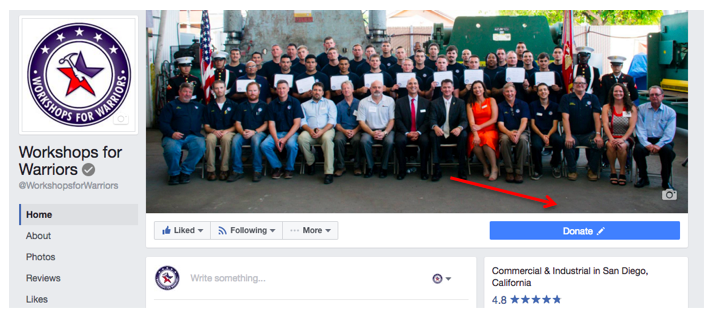10 ways nonprofits and small businesses can leverage social media

One great thing about social media marketing is that it can work for everyone—from a local flower shop to a church charity to a fortune 500 company, social media matters. Social media has something available for you in order to help your business be successful, so don’t be discouraged if you don’t have a huge following or a giant advertising budget. Below explains some best practices to leverage social media for your type of business:
1. Learn About the Different Social Platforms
There are a ton of different social media platforms available, so don’t just stick with the big fish like Facebook, LinkedIn, and Twitter. Each platform has unique characteristics, and so it’s important to learn about them all in order to figure out which one(s) will be the best fit for your nonprofit or small business. Below are just a few to consider: The Big Fish for All
- Facebook is a great way to reach a large audience, and they also offer customized targeting options if you’re looking to reach a specific group of people.
- Instagram is very social and mostly incorporates photo sharing and hashtags.
- LinkedIn is a great option if you’re looking to target a more professional audience.
- Twitter is great in conjunction with one of the other social giants, but individually it’s capabilities may not be sufficient for all your needs.
Potential Big Fish for Your Company
- Pinterest is excellent if you have a tangible product you would like to sell.
- Quora is a great way to establish leadership in your industry and improve brand recognition.
- SnapChat works well if you host a lot of events or travel often and cater to a younger audience.
- Don’t forget Google+ and YouTube. So these may be considered “Big Fish,” but many don’t even think of them as social media sites and therefore do not use them as social sites. Dig into their features to see if sharing and connecting via these platforms makes sense for you.
Just make sure to do your homework and don’t feel like you have to limit yourself to one site; use whatever site or combination of sites that makes the most sense for your entrepreneurial goals.
2. Figure Out Who Your Audience is and Where they Hang Out
After doing your research but before deciding on a platform, you’ll definitely want to determine who the audience is that you’re trying to reach through your business or philanthropic efforts. This should ultimately be the deciding factor when you determine which social media site(s) you want to utilize. Consider factors like age, gender, ethnicity, and interests. Which crowd does your product appeal to the most? Which group of people is most likely to donate to your charity and/or participate in your events? Check out this 2016 Pew Research study for more information about the average demographics you see with different social media platforms.
3. Use Three or Less Social Media Platforms
Once you’ve done all the necessary research on the various social sites, you’ve determined your audience, and have determined which places they like to frequent online, you can feel free to figure out which site(s) to spend time on for your business or nonprofit. While we encourage you to use more than one, I would definitely limit yourself to 3 sites or less. If not, you’ll find yourself constantly bouncing back and forth between sites and spending a ton of time trying to keep up with them all, which could lead to a decrease in quality. You’re better off focusing most of your efforts in the one or two places where you know you have a following and making sure everything you post is of value. Your audience will appreciate it and it will be easier to gain their loyalty.
4. Set Goals, Establish Metrics, and Come Up with a Plan
Before you dive headfirst into social media, you’ll want to set some goals for yourself. It can be challenging to quantify your success in this area, so it’s helpful to know upfront what you’re trying to gain through your efforts. If you’re a nonprofit, do you want to gain exposure? Or increase donations? If you’re a small business, are you trying to drive more traffic to your website? Gain more leads?
Regardless of what you’re looking for, come up with some metrics so you have an idea of how to test your successes and failures, and use this plus your goals to create a solid social media marketing strategy. Then, refer back to your plan frequently to determine if you are meeting your goals or if you need to rethink your plan.
Note: If you’re unsure where to begin, simply test out your social media sites for 3 months just to get some initial data to start with. It depends on the resources you have managing social media, but in many cases your goals should be approximately 25% higher than your average metrics after three months.
5. Build a Relationship with Your Followers
Social media is a great place to build loyalty and trust with your followers because you have the option to interact with them on a daily basis and you get to control the majority of those interactions. For example, if you’re a small business, it might not be the best idea to constantly post links to your sales page because this could be a huge turn-off for buyers who don’t want to be inundated with notifications asking them to buy things. The same goes for nonprofits; although your primary goal probably is to raise money, you shouldn’t use social media as a way to continuously ask for it.
Instead, keep your followers up-to-date on anything new going on with your business, ask them to provide feedback on your efforts (and then use it to improve), and definitely use it to increase exposure. Nonprofits especially should try to start “trending behavior,” like the ice bucket challenge for ALS. This is a great way to gain more followers while also meeting your monetary goals, and people respond well to acts of goodwill.
6. Nonprofits, Specifically- Don’t Forget to Tag all Volunteers and Donors in Any Pictures Posted Online (with Permission)
It’s a good idea for all businesses to acknowledge anyone who participates in an event or makes a conversion regardless of whether your company is for-profit or nonprofit, but nonprofits especially need to make sure they’re giving credit where credit is due. Volunteers and donors will be happy that their efforts are appreciated, and by tagging them online you’re also raising awareness for your cause. Friends and other businesses will see the exposure they’ve received and that may serve as motivation to get others involved as well. So make sure you’re taking pictures at fundraisers and events, and then don’t be afraid to share those photos online with the appropriate people tagged in them.
7. Tell Your Story Through Videos
 One great thing about nonprofits and small businesses is that they always have a story to tell, and if told correctly, that story can easily translate into customers, conversions, and donations. Don’t be afraid to give your audience some background on your business. How did you begin? What’s your background? What are your goals? What things are important to you? And for nonprofits especially, how do you use the funds that are donated?
One great thing about nonprofits and small businesses is that they always have a story to tell, and if told correctly, that story can easily translate into customers, conversions, and donations. Don’t be afraid to give your audience some background on your business. How did you begin? What’s your background? What are your goals? What things are important to you? And for nonprofits especially, how do you use the funds that are donated?
One great way to tell your story is through video. It can engage an audience who is much more likely to watch (and remember) a 30-second film than they are to read an extensive blog post. And since most social media platforms have embraced some form of Live video, now is a great time to log on, go Live, and start telling your story. Facebook Live is an especially useful tool because once you’re done streaming, the video is saved to your timeline and can be viewed later, or shared through your blog or other social media sites.
8. Check Out the Competition and Learn from Their Successes and Failures
You’re definitely not the only nonprofit or small business looking to leverage social media in your favor; social media has become such a huge part of marketing that oftentimes companies have whole teams devoted to the department and spend time on social media audits. They spend countless hours online learning about customer behavior and checking out the competition. As a small business or a nonprofit, especially, you probably don’t have the budget for this, but that doesn’t mean you have to miss out on vital information. All it takes is one person to go on the various social sites and conduct research into the competition. What are they doing that’s working? What seems to be failing? Check out how their customers are responding and then learn from their feedback.
9. Nonprofits Should Utilize the “Donate” Button on Facebook

Thanks to Facebook’s new fundraising tools, the era of online and mobile fundraising is definitely changing, and this is good news for nonprofits that know how to capitalize on social media. They’ve now developed a 2-click payment system that saves a donor’s credit card information and makes charitable giving a breeze. This could also suggest a trend towards donating through Facebook instead of through a nonprofit’s website. All you have to do is complete a brief application and then a “donate” button can be added to your Facebook page. You also have the option to add a fundraiser to your Facebook page. You can invite your friends to join the fundraiser, keep track of how many donors have contributed, and check your progress. Facebook is extremely conducive to philanthropy and nonprofits should definitely take advantage of this.
10. Be Willing to Put in the Work to Keep Content Fresh
Regardless of whether your business is for-profit or nonprofit, you have to be willing to spend the time necessary to keep your social media presence updated and fresh. Don’t go into this thinking it’s something that can be completely automated and that you only need to check on once in a while. Your audience will know if you’re taking shortcuts and that’s a great way to lose their trust and loyalty, and their money. They want to see new, updated content with value, but they don’t want to be overwhelmed by it. You don’t need to post multiple Facebook posts or send out a slew of tweets every single day, but you also shouldn’t go weeks without a new post.
Think ahead of time what you want to accomplish and how you want to do it, and then craft a schedule that works for you. Whatever you decide, make sure you stay consistent so your audience knows what to expect. Try to avoid making every post a sales pitch; instead, spend some time talking about the industry and how you’re contributing to the community. These things go a long way in building relationships with your followers.
What have you found to be the best ways to leverage social media for your business or nonprofit? Do you know of any best practices not listed above? Comment in the section below!













